Now You Know Study on Standard Spinning Testing Lab Equipments, Their Specifications and Functions
Sunday, 3 February 2019
Edit
Study on Standard Spinning Testing Lab Equipments, Their Specifications and Functions
Mustaque Ahammed Mamun
Department of Textile Engineering
Dhaka University of Engineering & Technology (DUET)
Cell: +8801723300703
Email: mamuntex09@gmail.com
Department of Textile Engineering
Dhaka University of Engineering & Technology (DUET)
Cell: +8801723300703
Email: mamuntex09@gmail.com
Introduction:
In textile industry, row material is the most dominant factor since it contributes 50-75% of total manufacturing cost. Any errors or negligence in selection and composition of raw material cannot be corrected by any means. Here omissions are beyond redemption.
In case of spinning industry the basic raw material is fiber which has a very high degree of variability. Its measurement is really a tough task but it is often said that if one can measure it then and only then he can manage it.
To observe the fiber testing instruments and procedure we have visited the Amber Cotton Mills, Banglabazzar, Gazipur which is a leading name in the textile sector of Bangladesh. They produce high quality knit yarn using the latest machinery. There cotton yarn is auto conned and spliced with the best modern machineries. The cotton yarn is Usterised and electronically cleaned. Amber has a complete range of latest USTER testing laboratory equipments.
Theory:
The quality of cotton varies considerably among the different varieties available. It is not easy to define quality in absolute terms. The most important fiber properties which determine the quality of cotton are its fiber length, fineness, maturity and strength.
Testing is a valuable aid to those connected to the production, distribution and consumption of textiles, if the instruments and techniques are used effectively. The right course of action may be taken from the results of testing. Hence it can be said that the testing is a means to an end.
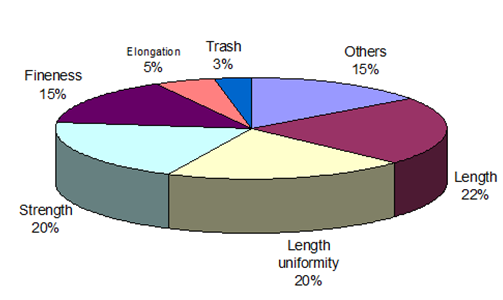 |
| Contribution of fiber properties to yarn quality |
Testing is the application of engineering knowledge and science to the measurement of the properties of textile fibers, yarns and fabrics. It involves the use of techniques, tools, instruments in the laboratory for the evaluation of the properties of these different forms of textiles.
Objects of the Assignment:
- To know about various testing machines.
- To know about the specifications of testing machines.
- To know about various functions of testing machines.
- To earnings knowledge about Q/C department.
- To judge proper characters of various samples such as fiber, yarn, sliver.
- To help various research for selection of raw material.
- For process control & product control.
- Wrap Block.
- Wrap Reel.
- Electronic Balance.
- Lea Strength Tester.
- Twist Tester.
- USTER HVI 1000
- USTER AFIS PRO.
- Evenness Tester: USTER Tester 5 (UT5).
- Yarn Moisture Meter.
- Digital Splicing Strength Tester.
Machine specification:
- Name: Wrap block
- Company: MAG
- Origin: India
Used for making Sliver and roving lea and count determination.
Necessary parameter:
Sample length (For sliver) = 6 Yards
Sample length (For roving) = 30 Yards
Weight unit= Weight both for sliver and roving is measured in grain.
Testing principle:
For sliver
6 yards sample is taken
↓
Wt of sample is measured in gr
↓
Then the wt is divided by 6 to get gm/yd
For Roving
30 yards sample is taken
↓
Wt of sample is taken in grain
↓
Then 250 is divided by the wt of sample to get the hank of sample.
For sliver
6 yards sample is taken
↓
Wt of sample is measured in gr
↓
Then the wt is divided by 6 to get gm/yd
For Roving
30 yards sample is taken
↓
Wt of sample is taken in grain
↓
Then 250 is divided by the wt of sample to get the hank of sample.
Experimental set up:
 |
| Fig: Wrap block machine |
Machine specification:
- Machine name: Wrap reel
- Company: MAG
- Origin: India
Used for making yarn lea and count measurement.
Necessary parameter:
- Sample length: 120 yards
- Reel circumference: 1.5 yards
- Revolutions for making 120 yards yarn lea: 80
- Traverse length: 1.5 inch
Testing procedure:
120 yards sample is made by wrap reel
↓
Wt of sample is measured in gm
↓
Then by adopting formula count is measured
120 yards sample is made by wrap reel
↓
Wt of sample is measured in gm
↓
Then by adopting formula count is measured
Formula used:
Count (Ne) = 64.8/Lea weight in gram
Experimental set up:
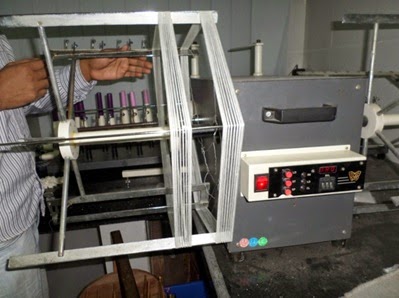 |
| Fig: Wrap reel machine |
Machine specification:
- Machine name: Lea strength tester
- Model No: EleStretch XT
- Company: MAG
- Origin: India
Used for determining the strength of yarn lea.
Necessary Parameter:
- Sample type: Yarn lea
- Sample length: 120 yards
- Clamp to clamp distance: 0.75 yards
- Strength unit: CSP (Count Strength Product)
Testing procedure:
120 yards sample is taken by Wrap reel
↓
Count is determined
↓
Then sample is set in machine
↓
Machine is run
↓
After the sample being broken the reading (breaking tension in lb) is taken
↓
Then by adopting formula CSP is calculated
120 yards sample is taken by Wrap reel
↓
Count is determined
↓
Then sample is set in machine
↓
Machine is run
↓
After the sample being broken the reading (breaking tension in lb) is taken
↓
Then by adopting formula CSP is calculated
Formula used for calculating CSP:
CSP=Count (Ne) X Breaking tension (lb)
Experimental set up:
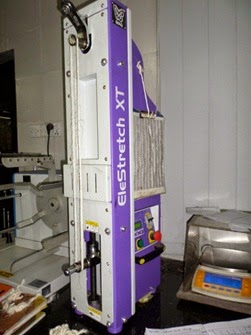 |
| Fig: Lea strength tester |
Machine specification:
- Machine name: Automatic twist tester
- Company: MAG
- Origin: India
Used for checking the TPI in yarn.
Testing procedure:
20 inch sample is set in machine
↓
Respective dead weight is inserted
↓
Machine run
↓
After the yarn being completely untwisted the machine is automatically stopped gives reading in display that indicates the TPI
20 inch sample is set in machine
↓
Respective dead weight is inserted
↓
Related:
↓
After the yarn being completely untwisted the machine is automatically stopped gives reading in display that indicates the TPI
Experimental set up:
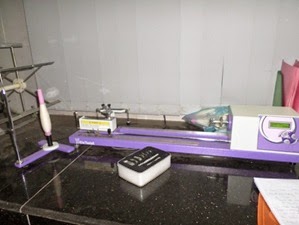 |
| Automatic twist tester |
Machine specification:
- Machine name: USTER HVI 1000
- Company: Zellweger USTER
- Origin: Switzerland
Used for testing the different parameters of cotton fiber.
Necessary parameter:
Measuring Sample weight: 9.5-10.5 gm
Modules:
- Length and strength
- Micronaire
- Color and trash
- Spinning consistency index
- Micronaire
- Maturity index
- Upper half mean length
- Uniformity index
- Short fiber index
- Strength
- Elongation
- Moisture
- Reflectance
- Yellowness
- Color grade
- Trash count
- Trash area
- Trash grade
SCI= -414.67 + 2.9 X Strength-9.32 X Micronaire + 49.17 X Length (inch) + 4.74 X Uniformity + 0.65 X Rd + 0.36 X b
Experimental set up:
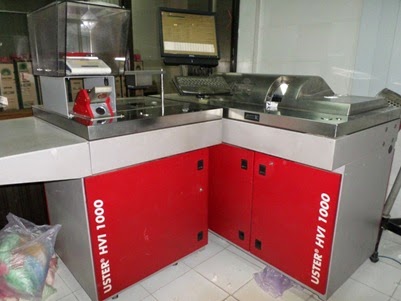 |
| USTER HVI 1000 |
Machine specification:
- Machine name: USTER AFIS PRO
- Company: Zellweger USTER
- Origin: Switzerland
Used for testing the different parameters of raw cotton and sliver.
Necessary parameter:
Measuring Sample weight = 0.40-0.60 gm
USTER AFIS PRO measures 3000 individual fibers to give a report.
Test Modules:
- NC( Nep classification) Module
- L & M( Length and Maturity) Module
- T (Trash) Module
1. NC (Nep classification) Module:
- Nep count per gram
- Nep size (micron)
- Seed coat nep count per gram
- Seed coat nep size (micron)
- Mean length
- Mean length by weight
- Length variation by weight
- Upper quartile length by weight
- Short fiber content by weight
- Mean length by Number
- Short fiber content by number
- Fineness(militex)
- Maturity ratio
- Immature fiber content
- Dust count per gram
- Dust size (micron)
- Trash size (micron)
- Visible foreign matter (%)
 |
| USTER AFIS PRO |
Machine specification:
- Machine name: Evenness tester
- Company: Zellweger USTER
- Origin: Switzerland
Used for determining the evenness of sliver, roving and yarn.
Experimental set up:
 |
| Evenness tester |
The above discussion gives an idea about main latest fiber testing techniques and this concludes that one can achieve higher accuracy with least time in this system. Fiber testing is an important part in the final product, so it is clear one can achieve great quality with accurate testing techniques, which were discussed in this paper. Apart from this, various methods are also included which will give proper results in fiber testing.
Sumber http://textilelearner.blogspot.com






